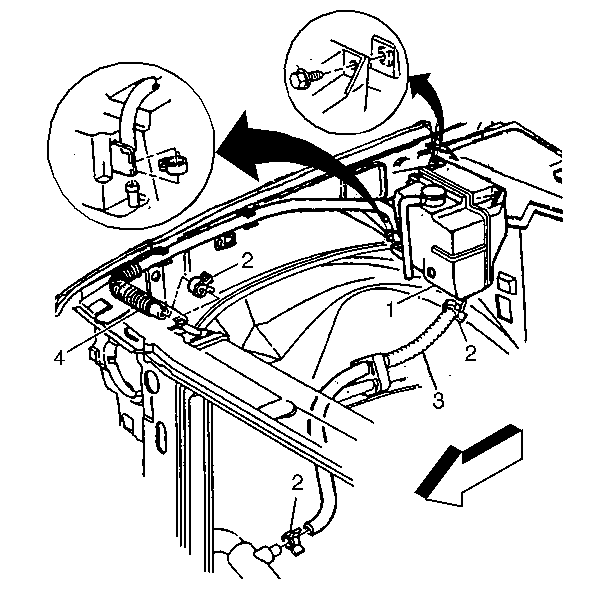For 1990-2009 cars only
Removal Procedure
- Drain the coolant from the surge tank.
- Disconnect the surge tank outlet hose (3) and clamp (2) from the surge tank as needed. The hose, mounting, and clips may vary from engine to engine.
- Disconnect the surge tank overflow hose (4) and clamp (2) as necessary. The overflow hose attachment may vary from engine to engine.
- Disconnect the surge tank inlet hose as necessary. The hose, mounting, and clips may vary from engine to engine.
- Remove the surge tank bolts.
- Remove the surge tank (1) from the vehicle.

Installation Procedure
- Install the surge tank (1) into the vehicle.
- Install the bolts.
- Connect the surge tank inlet hose as needed. The hose, mounting, and clips may vary from engine to engine.
- Connect the coolant overflow hose (4) and clamp (2) to the surge tank as needed. The overflow hose attachment may vary from engine to engine.
- Connect the surge tank outlet hose (3) and the clamp (2) to the surge tank. The hose, mounting, and clips may vary from engine to engine.
- Refill the coolant to the surge tank.

Notice: Use the correct fastener in the correct location. Replacement fasteners must be the correct part number for that application. Fasteners requiring replacement or fasteners requiring the use of thread locking compound or sealant are identified in the service procedure. Do not use paints, lubricants, or corrosion inhibitors on fasteners or fastener joint surfaces unless specified. These coatings affect fastener torque and joint clamping force and may damage the fastener. Use the correct tightening sequence and specifications when installing fasteners in order to avoid damage to parts and systems.
Tighten
Tighten the bolts to 10 N·m (89 lb in).
